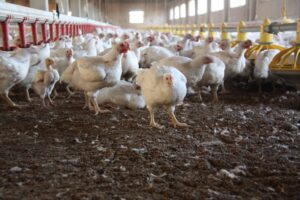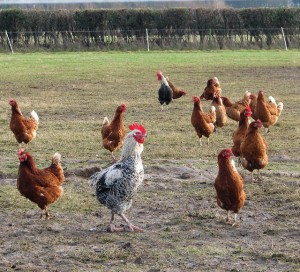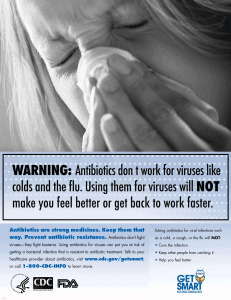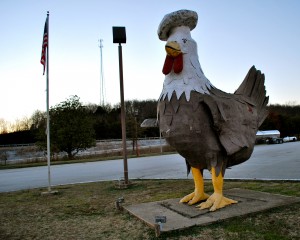Earlier in October, the USDA figured out where people were getting a nasty kind of salmonella. It’s resistant to many antibiotics. So far, 338 cases have been reported, and 40% of those people had to be hospitalized. It’s called Salmonella Heidelberg.
They were getting it from chicken. The chicken came from Foster Farms, a big west coast producer. It could be traced back to three of their plants.
When word got out, sales dropped by 25%. There were calls for Foster Farms to recall their chicken. Huge amounts of chicken.
Foster Farms declined. They said the chicken, even if permeated with Salmonella Heidelberg, is PERFECTLY SAFE TO EAT if you cook it enough. (165° F. Don’t you know anything?)
Maybe this is why the San Francisco Chronicle refers to Foster Farms as “Mired in a public relations fiasco.”
Ron Foster, the third generation of Fosters in the business, did some lovely media interviews to apologize and clear things up.
He said, “We truly regret any illness associated with our products.” On the company website, the S word appears: “I am sorry for any foodborne illness associated with our fresh chicken.” Last week, the Modesto Bee quoted a longer version, which added “and for any concern this may have caused you.” (Maybe somebody told them how dismissive that sounds of people who feel concerned BECAUSE THEY ARE IN THE HOSPITAL with horrible symptoms I will not describe in this dainty space.)
Foster said he was “horribly embarrassed,” but also complained that people always blame Foster Farms because it has nearly 65% of the broiler chicken market on the west coast. “If there is illness, two-thirds of the blame comes back to Foster Farms.”
Asked why Foster Farms didn’t recall their chicken, Foster said. “If we had pulled our product from the market and put someone else’s in, we’d be lying to the consumer because you’re saying someone else is better,” Foster said. “We couldn’t find anything that was broken.” (Nothing to do with cost, then?)
“Our brand was built on trust and I think we violated … our consumers’ trust. And it’s now our responsibility to earn it back and we plan on doing that by having a gold standard chicken in the market.”

Doc, I think the tetracycline upsets my stomach. Or maybe it’s the penicillin. Wait, am I still taking the ofloxacin?
He talked about changes Foster Farms is making, including vaccinating chickens for Salmonella Heidelberg, feeding them probiotics, sterilizing more stuff in the plants, retesting for salmonella after chicken has been cut up, and requiring companies that sell them chicks to certify the chicks are salmonella-free.
“[W]e are confident that Foster Farms will come out stronger and with the safest, cleanest and most vigilant poultry plants in the country.”
Robert O’Connor, a senior vice president and one of the company’s veterinarians, said Foster Farms did not plan to stop giving all its chickens antibiotics as a preventative measure. Foster added that without the antibiotics the chickens would get sick, maybe die. “We’re trying to grow a healthy product.”
Bad apology, Mr. Foster. “…any… illness associated with our… chicken”? Associated with? Much too vague about what you’re apologizing for.
Too much about your own suffering, your embarrassment, and the way people pick on Foster Farms because it’s so successful.
Evasive of responsibility – you’re not recalling your chicken because it’s perfectly fine, not broken, and just as good as all the other chicken? THEN WHY IS THERE AN OUTBREAK CAUSED BY CHICKEN FROM YOUR PLANTS?
The changes sound like improvements, but we’re not ready to hear about your glorious future, your increased strength, and your gold standards yet. Most of us are still worried about the chicken you didn’t recall.
What does this have to do with routine use of antibiotics? If chickens are sick, isn’t giving them antibiotics a good idea?
Poultry producers aren’t giving antibiotics to sick chickens. They don’t feel chickens’ foreheads to see if they’re feverish. Focusing on “herd health,” not on the health of particular chickens, they give antibiotics to all their birds all the time. They do this so the chickens have less chance to get sick in the first place, and because it makes them grow faster.
Factory farmed chickens are crammed together in huge numbers, making it easy for disease to spread. When it does, producers lose a lot of money.
However, the more we use antibiotics, the more bacteria develop resistance. Antibiotic resistance is a big problem. Many bacteria pass genes for antibiotic resistance around to other bacteria on plasmids, aka horizontal gene transfer, so resistance can move quickly into bacterial populations.
Must we talk about MRSA (stands for Methicillin-resistant Staphylococcus aureus, though it’s resistant to other antibiotics too – pronounced MURsa), and flesh-eating bacteria? No.
Often, when causes of widespread antibiotic resistance are discussed, people get blamed for going to doctors with viral ailments like colds and flus and demanding antibiotics even though ANTIBIOTICS DON’T TOUCH VIRUSES. This happens. I have also had doctors prescribe antibiotics to me for a viral illness, because they assumed I would irrationally demand them. (That’s crazy – I’m not the kind of senseless wacked-out all-caps-using loon who would do that.)
Right, blame the consumer. We will persist in eating raw chicken with our hands and then whining to our doctors for antibiotics.
But another thing people are worried about are the tons of antibiotics being shoveled into food animals. (Some people say 80% of antibiotics in the US go to livestock, but it’s not clear that’s an accurate number. The government doesn’t collect data on this.)
Naturally, industry says it’s not a problem, it hasn’t been proved it’s a problem, and the animals get different antibiotics. These days. Mostly.
Naturally, others disagree. Strongly.
This isn’t going to be resolved without more research. Industry cooperation would be nice. This is an industry that already has special “ag-gag” laws to maintain secrecy – good luck!
I’d like to hear Ron Foster vow that Foster Farms will promote such research. I’d like him to enlist his competitors in the poultry business. I’d like him to recall all chicken from the batches that have made people sick. That would be a real “gold standard.”







Would that we were all fortunate enough to purchase our food from local farmers, and could put factory farms out of business…
Uh Ron? Ron? Are you listening to yourself Ron?
The thing that makes Salmonella Heidelberg such a big problem, is that it is antibiotic resistant. And Ron, how did it get that way? By the indiscriminate use of…of…(wait for it Ron)…ANTIBI(F’ing)OTICS you DOLT!
(Capital using may be genetic.)
Sarah McC